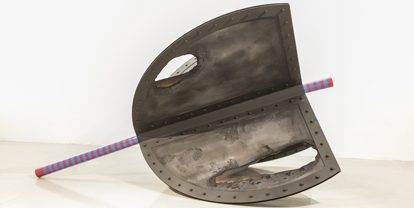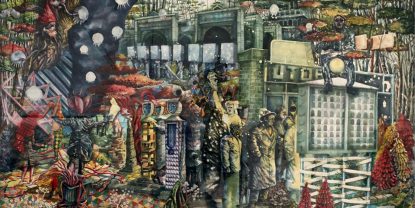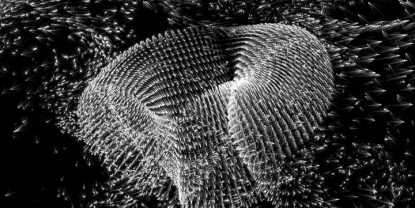Factory 01
Group Exhibition
June 29 — July 18, 2018
Mohsen Gallery is delighted to announce the group exhibition entitled “Factory 01” running from June 29 to July 18, 2018.
Adopting various approaches and using different media, ten artists represented by Mohsen Gallery show their works with an emphasis on personal narratives: from organic thoughts to thinking bodies, from places, events, and memories to fantasies and conscience awareness of pain and suffering. “Factory 01” is the tile of the group exhibition at Mohsen Gallery running from June 29 to July 18, 2018
At times, we see the complete absence of human subject and body, such as Gohar Dashti’s abstract “Still Life” series that makes references to a 19th century technique. The simplicity of form and content represented as fragmented elements, imply a probable order before the inevitable chaos and destruction. However, the artist seeks to make the pieces of this abstract nature cohere by making use of her feminine sensitivities.
In Mehrdad Afsari’s “Forty: A Treatise on Terrene Traverse,” the representation of the serene and illusive quality of the natural world and the viewer gaze at the distant horizon convey a faithful subject-object relation. Afsari combines the stillness and peacefulness of nature with a naked magnificence and a subtle absence. The number forty also refers to a “transition”: the age of forty is a border. Forty is a number that conveys patience, preparation, and above all, a new beginning.
Conversely, the literal depiction of emotions in Alireza Fani’s series engages the body in the clearest way. “Embrace” does not reveal psychological and physical phenomena about presence and touching bodies; rather, they have social implications with some sort of spontaneity. Unafraid of being seen and judged, human subjects cling together in interior and exterior settings.
Now moving from “events” to awareness and physical suffering, Using cannibal night-blinds in her series, “The Night-Blinds Do Not Show Mercy to Each Other,” Sara Abbasian deals with a theme that runs through most of her works, namely war. Not all wars start deliberately, but its victims suffer consciously. Carnivorous, night-blinds are the only mammals that can fly, which is why they are powerful and also destructive. Assault on enemy positions is not merely physical, but also psychological; like molesting a female body during the time of war in the battlefield. Mojtaba Amini’s collages, “Death is the Highest Orgasm,” address the same bodily concerns and psychological warfare with sexual implications.
Another form of imaginary representation of the body, which is more ambiguous, can be found in Arya Tabandehpoor’s “Bones” and “Portraits” series. He considers the body in terms of its fragility with a more imaginative approach: impermanence, imperfection, decadence, gradual degradation of functions, organism, and eventually, death.
Now we move from fantasy to memory, and from memory to space. With the Polaroid photographs of “The Dormant Yellow,” and “Exposed,” Sasan Abri moves from urban spaces to the memory. His works are representations of the city, which is a melting pot of settlements, activities, commute, and recreation. However, none of these things really make sense to the inhabitants. These are bits and pieces that look fragmented, patchy, and unrelated—before and even after construction.
When representation tends towards fantasy, it becomes void of social concerns. It is a process that makes the mind resort to defamiliarization and move towards human identity. In his “Heading Utopia” series, Behrang Samadzadegan’s point of departure in order to present his interpretation of Iran’s history is fantasizing about documents of Iranian political history in a journey towards his imaginary utopia. He questions, struggles, destroys, and creates, not considering the unchangeable fate of watercolor as contradictory to events, surrendering, triumphs/defeats, and our bewilderments in history. When aesthetic games come alive, historical factors start to fade. The events intermingle, just like the interwoven nature of watercolor: interrelated events constantly repeat themselves in different times and various forms.
In a temporal space or a localized time, every rhythm implies a spatio-temporal relation. As a consequence of this cycle, the spatio-temporal factors create an interconnected process; whether in the same direction with the flow or against it. Using the concepts of “anti-time” and “anti-cycle” in his video, “ʌntɪtʌɪmwʌɪz,” Ali Phi looks for balance and compromise not in moving along with the mainstream, but in moving against it. This divergent approach has been used with the elements of sound and image.
What remains from a disaster, a war, or a devastation is illegible, mutilated, and obscure remnants of things that no longer exist: unidentifiable pieces that do not signify or narrate anything. The aesthetic of Majid Biglari’s pieces and objects in “The Experience of Dishevelment,” however, is not trying to glorify destruction or represent devastation; rather, it is defined by giving meaning and identity to the remnants and somehow appropriating them. Biglari has his own personal narrative of the new function of the remnants of a disaster. The pieces that have come off the whole, the Factory, which is perhaps seeking to reclaim its former glory: to demand the (im)possible.











